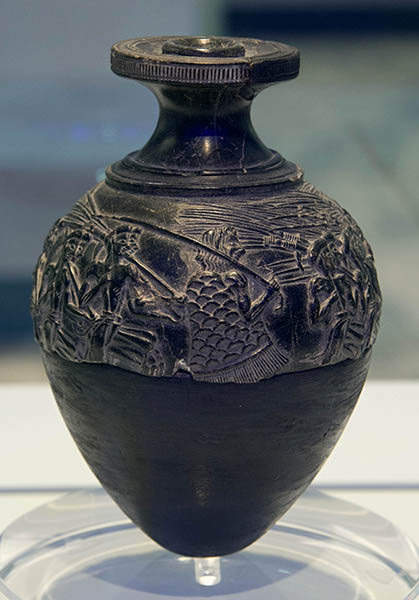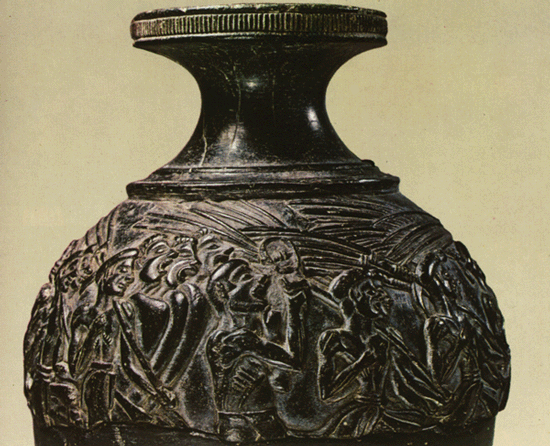Introduction: Uncovering a Minoan Masterpiece
In the early 1900s, a remarkable archaeological discovery on the sun-drenched island of Crete would captivate the world and provide unparalleled insights into the sophisticated Minoan civilization. It was the year 1902, and a team of archaeologists were meticulously excavating the ruins of Hagia Triada, an ancient Minoan settlement, when they stumbled upon a small but exquisite vessel that would become known as the Harvester Vase.

Crafted from gleaming black steatite and standing just 4 inches tall, this 3,500-year-old artifact immediately captivated scholars with its intricate, detailed designs. Dated to the period of 1550-1500 BC, the Harvester Vase stands as a testament to the Minoans’ remarkable artistic prowess and mastery of materials. Beyond its aesthetic beauty, this remarkable find would go on to offer invaluable glimpses into the spiritual, agricultural, and administrative aspects of Minoan society during the height of their civilization.
The Hagia Triada Excavations: Uncovering Minoan Treasures
The discovery site of Hagia Triada has long been recognized as a treasure trove for Minoan artifacts and cultural insights. Located on the southern coast of Crete, this ancient Minoan settlement was first excavated in the late 19th century, with more extensive digs taking place in the early 1900s under the direction of Italian archaeologist Federico Halbherr.
The Hagia Triada excavations have yielded a wealth of well-preserved Minoan ruins, artworks, and everyday objects, providing scholars with an unparalleled window into the lives and practices of this advanced Mediterranean civilization. From intricate frescoes and pottery to inscribed clay tablets, the artifacts uncovered at Hagia Triada have shed light on the Minoans’ sophisticated system of writing, their complex administrative structures, and the cultural and religious significance of their society.
The Harvester Vase: A Masterpiece of Minoan Art
At the heart of the Hagia Triada discoveries lies the captivating Harvester Vase, a small but exquisitely crafted vessel that has captured the imagination of historians and art enthusiasts alike. Measuring just 4 inches in height and 4.5 inches in diameter, this remarkable artifact is made from polished black steatite, a type of soapstone known for its durability and ability to take on intricate designs.

The Harvester Vase’s design is a true masterpiece of Minoan artistry, featuring a series of detailed relief carvings that depict a procession of robed figures, some carrying sickles or other agricultural implements. These figures are believed to represent harvesters or priests, offering a glimpse into the agricultural and religious practices of the Minoan people.
The vase’s exquisite craftsmanship and the level of detail captured in the relief carvings are a testament to the Minoans’ mastery of materials and their artistic sophistication. The figures are rendered with a remarkable level of realism, their flowing robes and expressive faces conveying a sense of movement and vitality that has captivated viewers for millennia.
Deciphering the Meaning of the Harvester Vase
Beyond its aesthetic brilliance, the Harvester Vase has also proven to be a valuable source of information about Minoan culture and beliefs. The procession of figures depicted on the vase has been the subject of much scholarly debate, with researchers offering various interpretations of the scene’s significance.

One of the most widely accepted theories is that the vase’s imagery represents a religious or ritual procession, perhaps related to the Minoans’ agricultural practices and the veneration of deities associated with the harvest. The presence of figures carrying sickles or other tools suggests a connection to the annual cycle of planting, growing, and reaping – a fundamental aspect of Minoan life and spirituality.
Additionally, the Harvester Vase’s discovery in the context of the broader Hagia Triada excavations has provided valuable insights into the administrative and social structures of Minoan society. The site’s wealth of inscribed clay tablets, seals, and other administrative artifacts has helped scholars piece together the Minoans’ complex system of record-keeping, governance, and religious practices.
The Harvester Vase and the Minoan Civilization
The Harvester Vase’s significance extends far beyond its artistic merits, as it serves as a tangible link to the rich cultural tapestry of the Minoan civilization. This remarkable artifact, dating back to the Second Palace Period of Minoan Crete (1550-1500 BC), offers a glimpse into the lives, beliefs, and practices of a society that flourished for centuries in the Mediterranean.

The Minoans, known for their advanced seafaring capabilities, extensive trade networks, and sophisticated palace complexes, were a highly advanced civilization that left an indelible mark on the ancient world. The Harvester Vase, with its intricate designs and symbolic imagery, reflects the Minoans’ deep connection to the natural world, their reverence for the cyclical rhythms of agriculture, and their rich spiritual and cultural traditions.
Preserving and Appreciating the Harvester Vase
Today, the Harvester Vase is carefully preserved in the collection of the Heraklion Archaeological Museum on the island of Crete, where it continues to captivate and inspire visitors from around the world. As one of the most iconic and well-preserved Minoan artifacts, the vase serves as a tangible link to a civilization that flourished thousands of years ago, reminding us of the enduring power of human creativity and the resilience of ancient cultures.
Through ongoing research, conservation efforts, and public exhibitions, the Harvester Vase remains a testament to the Minoans’ artistic brilliance and the enduring legacy of this remarkable Mediterranean civilization. As we continue to uncover and study the treasures of Hagia Triada and other Minoan sites, the Harvester Vase will undoubtedly continue to play a central role in our understanding and appreciation of this captivating ancient world.
Conclusion: The Enduring Legacy of the Harvester Vase
The discovery of the Harvester Vase in the early 1900s was a transformative moment in the study of the Minoan civilization, providing scholars with a tangible link to the artistic, spiritual, and agricultural practices of this remarkable ancient society. From its exquisite craftsmanship to the symbolic significance of its imagery, the Harvester Vase has captivated and inspired generations of historians, archaeologists, and art enthusiasts.
As we continue to explore the rich cultural heritage of the Minoans, the Harvester Vase remains a testament to the enduring power of human creativity and the enduring legacy of this sophisticated Mediterranean civilization. Through the preservation and study of this remarkable artifact, we can gain invaluable insights into the lives, beliefs, and practices of a people who lived and thrived on the sun-drenched island of Crete thousands of years ago.

